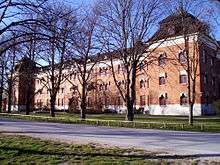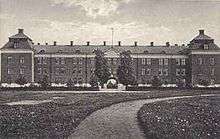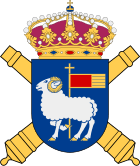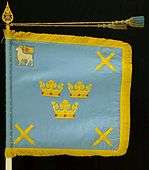Gotland Artillery Regiment
Coordinates: 57°37′59″N 18°18′3″E / 57.63306°N 18.30083°E
| Gotland Artillery Regiment | |
|---|---|
|
Gotlands artilleriregemente (A 7) | |
|
Insignia | |
| Active | 1811–2000 |
| Country |
|
| Branch | Swedish Army |
| Type | Artillery |
| Size | Regiment |
| Part of |
VII. milot (1942–1966) Milo Ö (1966–1982) MKG (1982–1994) Milo M (1994–2000) |
| Garrison/HQ | Visby |
| Patron | Saint Barbara |
| Colors | Green (1884-2000) |
| March | "Gotlands artilleriregementets marsch" (Wilhelm Löfdahl)[1] |
| Decorations |
GotartregGM (1947/1990) GotartregSM (1947/1990) GotartregMM (2000) |
The Gotland Artillery Regiment (Swedish: Gotlands artilleriregemente, designation A 7) was a Swedish Army artillery regiment that was in active service between 1811 and 2000. The regiment was based in Visby as part of the Gotland Garrison.
History
The regiment origins from the Artillery Conscripts of the Gotland National Conscription (Gotlands nationalbevärings artilleribeväring), which were organized in 1811 as a result of the Russian occupation of Gotland in 1808 and by a convention adopted by the islanders in December 1810, which was ratified by King Charles XIII on 5 February 1811. It consisted then of two artillery batteries and a fortification company with a squad of 100 men, located in Visby.[2] The unit was reorganized in 1861 into Gotland National Conscription Artillery Corps (Gotlands nationalbevärings artillerikår) and was given the designation No 4. In 1887 the corps changed its name to Gotland Artillery Corps (No 4). The Gotland Artillery Corps was redesignated No 7 in 1892 so that the planned Norrland Artillery Regiment could become No 4. In 1914 the name was changed to A 7.
In conjunction with the so called OLLI reform, which was carried out by the Swedish Armed Forces in 1973 and in 1975, A units and B units were created. The A units were regiments responsible for a defence area, and the B units were training regiments. In Gotland's case, it distinguished itself from the allotment on the mainland. This when the VII. Military Area was reorganized into Gotland Military Command (MKG) in 1966. The military command constituted a special command and control organization within the Eastern Military District, but did not have the overall responsibility for the administration of the island. Furthermore, the professional mobilization was led on a unit level. Through the reform, the full mobilization and material responsibility within the military command was added, regardless of military branch. This meant that the Gotland Artillery Corps which was included in the Gotland Military Command (MKG) came to be a B unit (training regiment). By the reform, the corps adopted the new name Gotland Artillery Regiment on 1 July 1975.[3]
Prior to the 1977 and 1982 Defence Policies, the Gotland Artillery Regiment was exempted from the investigation carried out by the National Institute of Defence Organization and Management (Försvarets rationaliseringsinstitut). In the 1977 Defence Policy, the Gotland Artillery Regiment was exempted because of regional political conditions. Instead the National Institute of Defence Organization and Management believed that the Småland Artillery Regiment (A 6) with the Artillery Cadet and Aspirant School (Artilleriets kadett- och aspirantskola, ArtKAS) as well as the Miloverkstaden in Jönköping would be disbanded. The Supreme Commander and the Chief of the Army, however, believed that no artillery regiment would be disbanded. However, the National Institute of Defence Organization and Management suggested in their investigation to give the Supreme Commander the task of examining the further development of the OLLI organization. In a further development, it wanted to merge Gotland Regiment (P 18), Gotland Artillery Regiment (A 7) and Gotland Anti-Aircraft Battalion (Lv 2) into an army regiment.[4]
Prior to the 1982 Defence Policy, the Boden Artillery Regiment, Gotland Artillery Regiment, Norrland Artillery Regiment, Wendish Artillery Regiment and the Bergslagen Artillery Regiment were exempted from the review of finding a cost reduction within the artillery. The Gotland Artillery Regiment were exempted from the investigation of disbandment, partly because of regional policy considerations but also demands for the war organization's preparedness and mobilization. The merger proposed by the government to the Riksdag in the previous policy had not been implemented. This meant that the government once again proposed to the Riksdag to merge the staffs of the Gotland Regiment, Gotland Artillery Regiment and the Gotland Air Defense Battalion with the staff of the Gotland Military Command, and form an authority from 1 July 1982.[5][6]
Through the 1992 Defence Policy, the Gotland Military Command was separated from the Gotland Regiment, Gotland Artillery Regiment and the Gotland Air Defense Corps, and formed independent units from 1 July 1994. The military command came to only lead all operations on Gotland, which on the mainland were solved by the defense area staffs, division staffs and naval command staffs.
Prior to the 2000 Defence Policy, the government proposed in its Bill 1999/2000:30 that only one artillery regiment would remain in the basic organization. The regiments which the government wanted to disband included Gotland Artillery Regiment. This in the light that the government considered it unsuitable to centralize the artillery training to Gotland, not least due to the investment needs and the limited opportunities for long-term manpower. Remaining in the artillery of the new basic organization was the Bergslagen Artillery Regiment, this because the government considered that to be the regiment which had the best conditions for long-term training and practice of artillery units. On 30 June 2000, the Gotland Artillery Regiment was disbanded.[7] On 1 July 2000, the Bergslagen Artillery Regiment took the new name the Artillery Regiment.
Operations
In 1901 the corps was reorganized, and was increased so that it amounted to three batteries and a position company with a strength of 21 officers, 14 noncommissioned officers, four civilian servicemen and 156 male permanent workers.[2] In the 1990s, the regiment was responsible for training of divisions artillery staff and battalions and brigade artillery battalions and armored artillery battalion included in the Gotland Military Command (MKG). When the Svealand Artillery Regiment was disbanded, primary weapon systems of the regiment, Haubits 77B, were transferred to Gotland Artillery Regiment.
Companies
- Wisborgs Company (21.)
- Stålhatts Company (22.)
- Carlswärds Company (23.)
Barracks and traning grounds
Barracks

The units first barracks were located at S:t Hansgatan 19 in Visby, where it was located from 8 November 1839. On 8 June 1893 some parts of the unit were relocated to Grahams Mechanical Workshop at Hamnplan 1. In 1902 some parts of the unit were relocated to Strandgatan 12-14. On 13 April 1909, the unit moved into newly built barracks at Östra Hansegatan 28. The unit was located at Östra Hansegatan until 30 June 1986, when it was from 1 July 1986 colocalized with the Gotland Regiment at Langs väg 4. On 24 May 1986 a closing ceremony was held at Östra Hansegatan. At the Gotland Regiment, the unit moved into the Barracks 1, which was highlighted by a ceremony on 7 October 1988.[8]
Traning grounds
The regiment's first traning ground was located 18 km northeast of Visby at Martebo mire. From 1 August 1898 it used Tofta firing range, located about 6 km south of Visby.[8]
Heraldry and traditions
The regiment was awarded its banner by King Gustaf V on his birthday on 16 June 1938. After the Svealand Artillery Regiment was disbanded on 31 December 1997, its banner and traditions was transferred to the Gotland Artillery Regiment. Gotland Artillery Regiment carried the banner to the side of its own until it was disbaned on 30 June 2000. The banner of the Svea Artillery Regiment was taken over by the Artillery Regiment.[9]
The traditions of the Gotland Artillery Regiment are preserved since 1 July 2000 by the Artillery Regiment. The traditions were preserved from 2000 to 2005 by the Gotland Regiment (P 18). A special manifestation on the day of the disbandment took place and a march was conducted through Visby with visits to a number of "A 7 places". The closing ceremony took place in the Donnershage which included the handover of the A 7's banner to the Artillery Regiment. At tattoo, the unveiling of the memorial stone placed in front of chancellery of the Gotland Regiment took place.[10]
At the regiment, the Gotland Artillery Regiment Medal of Merit (Gotlands artilleriregementes förtjänstmedalj) in gold and silver was instituted in 1947 and 1990. The ribbon: green, red, green. In 2000, the Gotland Artillery Regiment Memorial Medal (Gotlands artilleriregemente minnesmedalj) in silver was instituted. The ribbon: red, green, red.[9]
|
Commanding officers
Commanding officers of the artillery on Gotland from 1860 to 2000. The commanding officer had the title corps commander between 1860 and 1975. The commanding officer had the title regimental commander between 1975 and 1982 and 1994 to 2000. During the years 1982-1994, the commanding officer was subordinate to the commanding officer of the Gotland Military Command (MKG).
- 1860–1868 – Lt. Colonel Christer d'Albedyhll
- 1868–1879 – Lt. Colonel Carl Edvard E af Chapman
- 1879–1884 – Lt. Colonel Thiodolf Bernhard Borgh
- 1884–1886 – Lt. Colonel Frans Thomas Schartau
- 1887–1894 – Lt. Colonel Frans Thomas Schartau
- 1894–1895 – Lt. Colonel Claes Johan Viktor A. Meurling
- 1895–1906 – Lt. Colonel Alexander Johan Baltzar von Strussenfelt
- 1906–1909 – Lt. Colonel Gabriel Axel Torén
- 1909–1911 – Lt. Colonel Karl Osvald Toll
- 1911–1913 – Lt. Colonel Claes Axel Breitholtz
- 1913–1915 – Lt. Colonel John Gustaf Gerhard Améen
- 1915–1919 – Lt. Colonel Bo Arvid Tarras-Wahlberg
- 1919–1926 – Lt. Colonel Bertil Lilliehöök
- 1926–1927 – Colonel Carl Georg Ohlson
- 1928–1931 – Colonel Gunnar Ludvig Malkolm Salander
- 1931–1934 – Lt. Colonel Per Falk
- 1934–1939 – Colonel Carl-Gustaf David Hamilton
- 1939–1941 – Lt. Colonel Gustaf Dyrssen
- 1941–1943 – Colonel Curt Sixten Reinhold Kempff
- 1943–1945 – Colonel Ivar Bert Tyko Carpelan
- 1945–1947 – Colonel Erik Thorsten Berggren
- 1947–1949 – Colonel Arvid Mauritz Eriksson
- 1949–1953 – Colonel Nils Oskar Söderberg
- 1953–1959 – Colonel Göran Schildt
- 1959–1970 – Colonel Tore Edvard Deutgen
- 1970–1974 – Colonel Stig Alrik Nihlén
- 1974–1975 – Lt. Colonel Karl-Erik Bellvar Kennerby
- 1975–1978 – Colonel Carl Arcadius Holger Areskoug
- 1978–1980 – Colonel Reinhold Lahti
- 1980–1982 – Colonel Erik Helge Gard
- 1982–1990 – Lt. Colonel Curt-Christer Bertil Gustafsson
- 1990–1991 – Colonel Hans Gunnar Dellner
- 1991–1992 – Lt. Colonel Kjell Åke Plantin
- 1992–1999 – Colonel Bengt Olof (Olle) Allan Bjurström
- 1999–2000 – Lt. Colonel Sven-Åke Asklander
- 2000–2000 – Lt. Colonel Bo Hansson
Names, designations and garrison

| Period | Name | Translation |
|---|---|---|
| 1811-02-05 – 1861-07-15 | Gotlands nationalbevärings artilleribeväring | Gotland National Conscription's Artillery Conscripts |
| 1861-07-16 – 1886-12-31 | Gotlands nationalbevärings artillericorps | Gotland National Conscription's Artillery Corps |
| 1887-01-01 – 1974-12-31 | Kungl Gotlands artillerikår | Royal Gotland Artillery Corps |
| 1975-01-01 – 1975-06-30 | Gotlands artillerikår | Gotland Artillery Corps |
| 1975-07-01 – 1982-06-30 | Gotlands artilleriregemente | Gotland Artillery Regiment |
| 1994-07-01 – 2000-06-30 | Gotlands artilleriregemente | Gotland Artillery Regiment |
| Designation | Period |
|---|---|
| – | 1811-02-05 – 1861-07-15 |
| No 4 | 1861-07-16 – 1892-12-31 |
| No 7 | 1893-01-01 – 1914-09-30 |
| A 7 | 1914-10-01 – 1982-06-30 |
| A 7 | 1994-07-01 – 2000-06-30 |
| Garrison | From | To | |
|---|---|---|---|
| Different location inside Visby inner city, For example, Södertorg | 1836 | – | 1886 |
| Hamnplan, Visby | 1886 | – | 1909 |
| Korsbetningen, Visby | 1909 | – | 1986 |
| Visborgsslätt, Visby | 1986 | – | 2000 |
See also
References
- ↑ Sandberg, Bo (2007). Försvarets marscher och signaler förr och nu: marscher antagna av svenska militära förband, skolor och staber samt igenkännings-, tjänstgörings- och exercissignaler (in Swedish) (New ed.). Stockholm: Militärmusiksamfundet med Svenskt marscharkiv. p. 201. ISBN 978-91-631-8699-8. LIBRIS 10413065.
- 1 2 Westrin, Theodor, ed. (1909). Nordisk familjebok: konversationslexikon och realencyklopedi. Bd 10 (in Swedish) (New, rev. and richly ill. ed.). Stockholm: Nordisk familjeboks förl. p. 29. LIBRIS 8072220.
- ↑ "Kungl, Maj:ts proposition 1974:135" (PDF) (in Swedish). Riksdag. 25 October 1974. Retrieved 23 July 2016.
- ↑ "Regeringens proposition 1977/78:65" (PDF) (in Swedish). Riksdag. 17 December 1977. Retrieved 23 July 2016.
- ↑ "Regeringens proposition 1981/82:102" (PDF) (in Swedish). Riksdag. 24 February 1982. Retrieved 23 July 2016.
- ↑ Bjurström, Olle. "Artilleriet på Gotland 1711-2000" (.doc). www.a7kamratforening.se (in Swedish). A 7 Kamratförening. pp. 3–4. Retrieved 23 April 2014.
- ↑ "Regeringens proposition 1999/2000:30" (PDF) (in Swedish). Riksdag. 18 November 1999. Retrieved 10 July 2016.
- 1 2 Holmberg, Björn (1993). Arméns regementen, skolor och staber: [en uppslagsbok] : en sammanställning (in Swedish). Arvidsjaur: Svenskt militärhistoriskt bibliotek (SMB). pp. 27–28. ISBN 91-972209-0-6. LIBRIS 7796532.
- 1 2 Braunstein, Christian (2003). Sveriges arméförband under 1900-talet. Skrift / Statens försvarshistoriska museer, 1101-7023 ; 5 (in Swedish). Stockholm: Statens försvarshistoriska museer. pp. 205–207. ISBN 91-971584-4-5. LIBRIS 8902928.
- ↑ Hansson, Bo (2000). "C A 7 har sitt "sista" ord" (PDF). Gotlandsartilleristen (in Swedish). Visby: Gotlands artilleriregemente (12): 4–5. LIBRIS 3136300. Retrieved 23 April 2014.
Further reading
| Wikimedia Commons has media related to Gotlands artilleriregemente. |
- Bjurström, Olle, ed. (2000). Artilleriet på Visborgs slätt (in Swedish). Visby: A 7 kamratfören. LIBRIS 8238170.
- Gavel, Peter; Gavel, Margareta (1987). Korsbetningen 1986: fotografisk dokumentation (in Swedish). [Visby]. LIBRIS 656837.
- Mosséen, Ulf, ed. (1986). Artilleriet vid Korsbetningen: [minnesskrift i anledning av Kungl. Gotlands artilleriregementes flyttning från Korsbetningen till Visborgs slätt den 1 juli 1986] (in Swedish). Visby: Regementet. LIBRIS 626155.
External links
- Website about Gotland Artillery Regiment (Swedish)
- Association of Gotland Artillery Regiment (Swedish)



